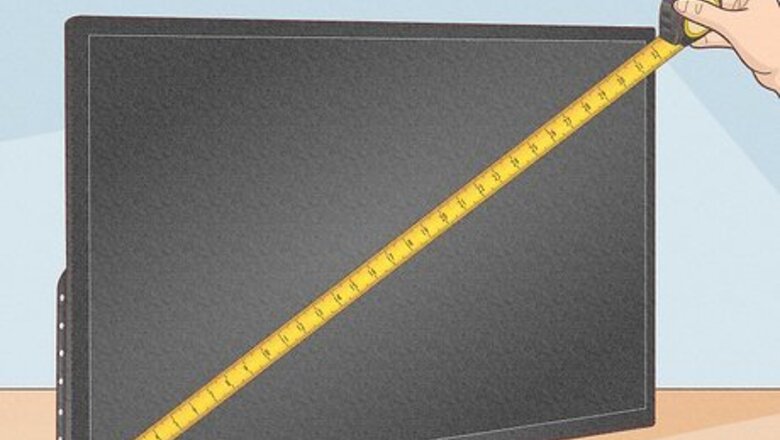
views
- TV manufacturers determine a TV's screen size by measuring diagonally from corner to corner.
- To find the best viewing distance from your TV, multiply the diagonal screen size by 1.2.
- To make sure your TV will fit on your shelf, you need to measure the height, width, and depth of the TV.
Measuring the Screen
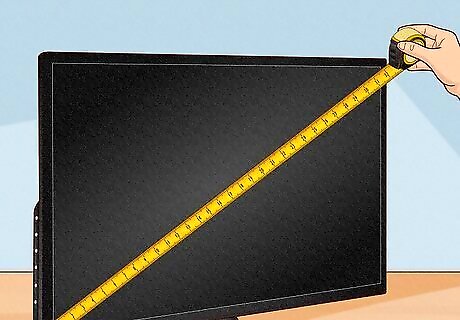
Place a tape measure diagonally on the screen. Place one end of your tape measure or measuring stick in the lower-left corner of your TV screen, and measure upward to the upper-right corner. Note the distance of the screen from corner to corner. This is how most TV manufacturers measure the screen size that's listed in your TV's packaging or box, as well as in advertisements. The measurement on your TV's box or packaging only includes the screen size. It does not include the frame (also known as the bezel), which can add extra inches to the overall size. If you just want to know the size of the screen and not the whole TV, make sure you are only measuring the screen size and not the frame. To find out if your TV is going to fit on your shelf, you need to measure the entire TV. TVs come in a variety of sizes. Smaller TVs range from 24 in (61 cm) to 32 in (81 cm). Mid-sized TVs can range from 42 in (110 cm), up to 48 in (120 cm). Larger TVs can range from 55 in (140 cm) to 85 in (220 cm), or larger.
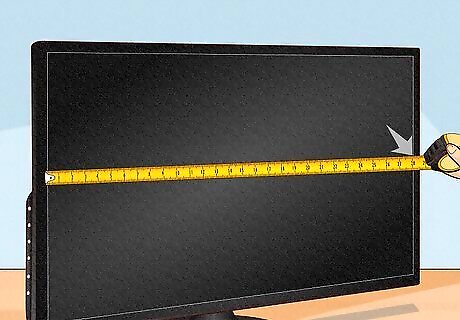
Measure the width of your TV screen. If you want to know the width of your screen, you can measure the length of your screen from left to right. Make sure you are only measuring the screen and not the bezel. The diagonal size of your TV is different from the width and height of your TV. The width of a TV screen is usually slightly smaller than the advertised screen size on the box.
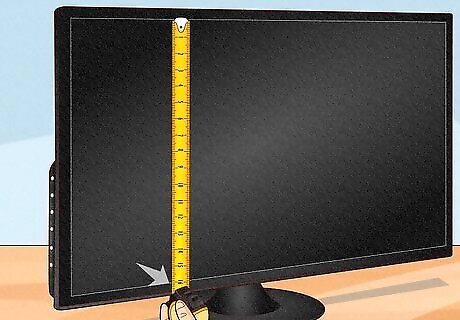
Measure the height of your screen. To determine the height of your TV screen, you can run the tape measure or measuring stick vertically from the top of the screen to the bottom. Again, make sure you are only measuring the screen and not the bezel if you just want to know the true screen size.
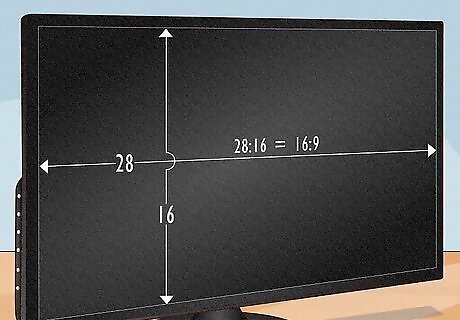
Determine the aspect ratio of your screen. The aspect ratio of your TV's screen is the width and height (W:H). You can find the aspect ratio of your TV screen by measuring the width and the length, and then then simplifying the two numbers. In most cases, older standard TVs have a 4:3 aspect ratio, while modern rectangular HDTVs have a 16:9 aspect ratio. The devices connected to your TV might have a different aspect ratio than your TV. If the aspect of your TV doesn't match up with your movie, game, DVD, or other video, you may see black bars on the screen or notice blurriness.
Finding the Best Viewing Distance
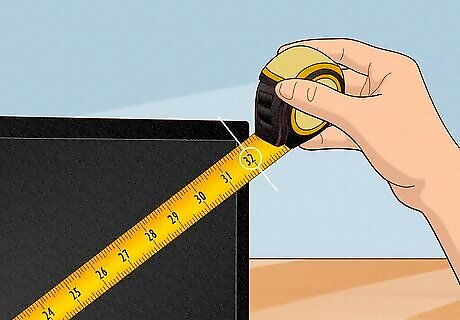
Measuring the screen size diagonally. If you want to figure out the proper viewing distance from your TV, starting by measuring the TV screen from corner to corner, diagonally. Make sure you are measuring just the screen and not the bezel. This can help you determine the best place to mount your TV and position your furniture.
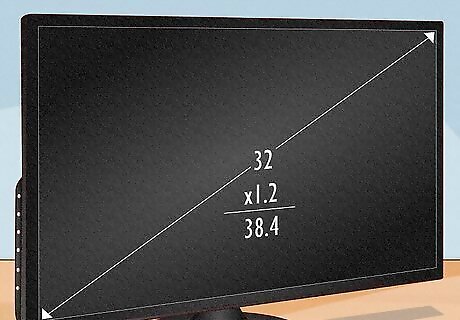
Multiply the number by 1.2. Whatever number you got by measuring the screen size diagonally, multiply it by 1.2. This will tell you how many inches (or centimeters) your viewing area should be from the TV. The TV should take up about 40% of your field of view when you are sitting and watching it.
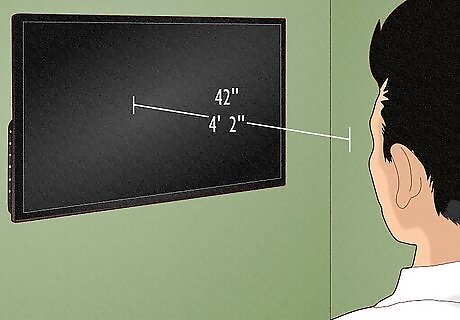
Convert the number to feet or meters. You can convert inches to feet by dividing the number by 12. You can convert centimeters to meters by dividing the number of centimeters by 100. The following lists the viewing area from the size of your TV: 42 in (110 cm) TV: 4.2 ft (1.3 m) viewing distance. 48 in (120 cm) TV: 4.8 ft (1.5 m) viewing distance. 50 in (130 cm) TV: 5 ft (1.5 m) viewing distance. 55 in (140 cm) TV: 5.5 ft (1.7 m) viewing distance. 60 in (150 cm) TV: 6 ft (1.8 m) viewing distance. 65 in (170 cm) TV: 6.5 ft (2.0 m) viewing distance. 70 in (180 cm) TV: 7 ft (2.1 m) viewing distance. 75 in (190 cm) TV: 7.5 ft (2.3 m) viewing distance. 85 in (220 cm) TV: 8.5 ft (2.6 m) viewing distance.
Measuring an Entire TV
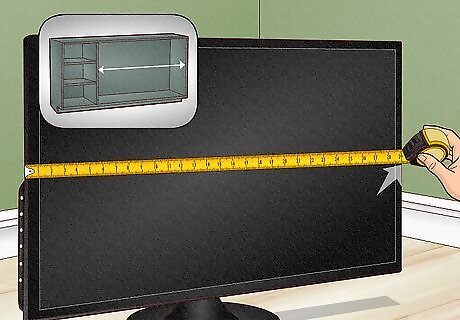
Measure the width of the TV. While knowing your screen size is useful for finding the proper viewing distance, it won't help you determine if your TV will fit on your shelf or cabinet. To do that, you will need to measure your entire TV, including the frame or bezel. To do so, use a tape measure or measuring stick to measure your TV horizontally (left to right), from edge to edge. Make sure you keep your tape measure or measuring stick level. Some TVs have a stand with legs that protrude out from the sides of the TV. If you are using a TV that has legs that extend beyond the left and right sides, make sure you measure the distance from the edge of one leg to the other to ensure your TV will sit properly on the shelf or stand.
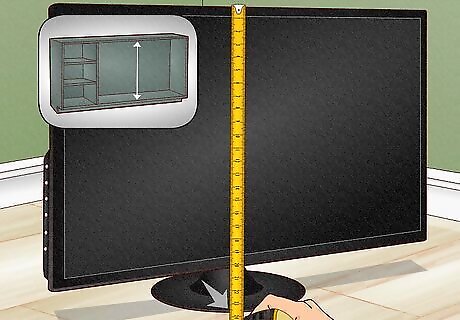
Measure the height of the TV. If the area you are placing your TV on has another shelf or platform above it, you need to know the height of your TV to make sure it fits. Measure the distance along the edges of the TV from top to bottom to determine the height of your TV. If your TV has a stand or legs, you will need to include the height of the TV with the stand. Place the TV on the stand and measure the distance from the top of the TV to the surface it is sitting on. Make sure you keep your measuring stick parallel to the left or right edge of the TV.
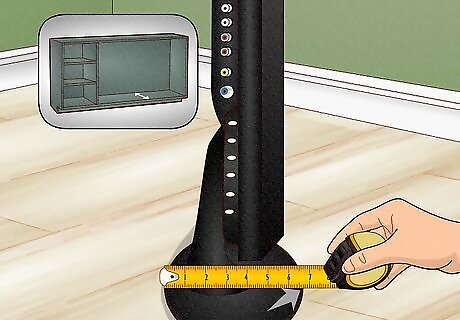
Measure the depth of the TV. Knowing the depth of the TV can help you determine whether it will fit in a cabinet or on a shelf. Or, if you're mounting the TV on a wall, you'll know how far the TV will stick out. To measure the depth of your TV, measure the distance from the front of your TV to the furthest point on the back of your TV. If the back of your TV is not flat, you can hold a measuring stick against the furthest point from the back of your TV so that it extends past one of the edges. Keep the measuring stick parallel to the front of your TV. If you are using a TV stand, you will also need to include the depth of the TV stand legs if they stick out in front or back of your TV. Measure from the front of the stand to the furthest point on the back of your TV.
Measuring Your Space for Proper Placement
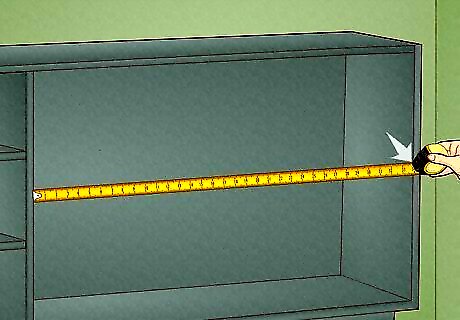
Measure the width of the TV shelf. When determining if a TV will fit, first start by measuring the width of the area where the TV sits. Make sure it is wide enough to fit the entire width of the TV and the legs the TV sits on. There should be a few inches to spare on both sides of the TV so the TV can vent properly.
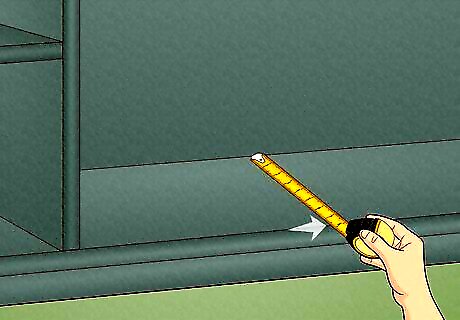
Measure the depth of the TV shelf. Measure the TV shelf from front to back to make sure it has enough room to fit the entire TV thickness as well as the TV stand or legs it sits on. Again, there should be a couple of inches to spare in the back for access so the TV can vent.
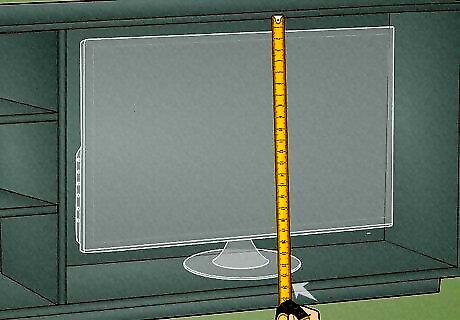
Measure the height of the TV shelf. If the area you are placing the TV has any sort of shelf or platform above it, you will need to measure the height of the area. Make sure there is enough vertical room for the TV and any stand the TV is sitting on.



















Comments
0 comment